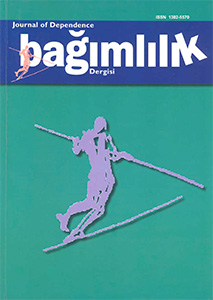Association of alcohol using measures with screening tests and biochemical markers
Keywords:
Alcohol, AUDIT, CDT, GGT, MCVAbstract
Objective: Screening tests and biochemical markers were useful items in the diagnosis of alcohol using disorders. Relationship of these markers and screening tests with alcohol measures were mentioned in only few studies. We aimed to investigate association between alcohol measures and alcohol using disorders identity test (AUDIT) and biochemical marker levels.
Method: 48 male patients whom were diagnosed as alcohol addiction according to DSM-IV criteria were admitted to our study. Alcohol measures like years of alcohol consumption, average standard drink, epileptic seizure and delirium history were wrote down and the association of these parameters with AUDIT and biochemical markers like CDT, GGT and MCV were investigated. Data was evaluated with SPSS 13.0 program.
Results: Both CDT level and AUDIT scores were associated with average standard drink. There was an also association between CDT and years of alcohol consumption. There was statistically significant difference between CDT levels of patients with and without a history of epileptic seizure. No association between addiction parameters and GGT and MCV levels were detected.
Conclusions: CDT was superior to other markers and AUDIT in our setting. Previous studies were supporting our findings generally. Repeating of these findings with comprehensive studies would elucidate clinical practice.
References
Şengül CB, Şengül C, Dilbaz N, Okay T. Alkol kullanım bozukluklarında yeni bir biyokimyasal belirleyici: Carbonhydrate Deficient Transferrin (CDT)Bağımlılık Dergisi 2004; 5:139-146.
Leon DA, McCambridge J. Liver cirrhosis mortality rates in Britain from 1950 to 2002: an analysis of routine data. Lancet 2006;367:52-6.
Shkolnikov V,McKeeM, LeonDA. Changes in life expectancy in Russia in the mid-1990s. Lancet 2001;357:917-21.
Niemela O. Biomarkers in alcoholism. Clin Chim Acta. 2007;377:39-49
Gül S, Akvardar Y, Taş G, ve ark. Alkol Kullanım Bozukluklarında Tarama Testleri ve Laboratuar Belirleyicilerinin Tanısal Etkinliği. Türk Psikiyatri Dergisi 2005;16:3-12.
Bean P, De Bruin T, Harasymiv J, et al. New applications of contemporary biomarkers of alcohol consumption. Am Cllnl Lab2002;21:19-21.
Aalto M, Seppa K. Use of laboratory markers and the audit questionnaire by primary care physicians to detect alcohol abuse by patients. Alcohol Alcohol. 2005;40:520-3.
Evans SM, Levin ER, Brooks DJ, Garawi F. A pilot double-blind treatment trial of memantine for alcohol dependence. Alcohol Clin Exp Res. 2007;31:775-82.
Kim SM, Kim JS, Kim KM, et al. Carbohydrate-deficienttransferrinasamarkerofheavydrinking in Korean males.] Korean Med Sci. 2007;22:652-5.
Hietala J, Koivisto H, Anttila P, Niemela O. ComparisonofthecombinedmarkerGGT-CDTand the conventional laboratory markers of alcohol abuse in heavy drinkers, moderate drinkers and abstainers.Alcohol Alcohol. 2006;41:528-33.
Dolman JM, Hawkes ND. Combining the audit questionnaire and biochemical markers to assess alcohol use and risk of alcohol withdrawal in medical inpatients. Alcohol Alcohol. 2005;40:515-9.
Reynauld M, Schwan R, Loiseaux-Menuier MN, et al. Patients Admitted to emergency services for drunkenness: moderate alcohol users or harmful drinkers? Am J Psychiatr. 2001 ;158:96-99.
Hermansson U, Helander A,Brant L, et al. The alcohol use disorder identification test and CDT in Alcohol related sickness absense. Alcohol Clin Exp Res 2002;26:28-35.
Brathen G, Bjerve KS, Brodtkorb E,et al.Validty of CDT and other markers as diagnostic aids in the detection of alcohol related seizures.] Neurol Neurosurg Psychiatry 2000;68:342-348.
Bohn MJ, Babor TF, Kranzler HR. The Alcohol Use Disorders Identification Test (AUDIT): validation of a screening instrument for use in medical settings. J Stud Alcohol. 1995;56:423-32.
Saatçioğlu Ö, Evren C, Çakmak D. Alkol kullanım bozuklukları tanıma testinin geçerliği ve güvenirliği. Türkiye'de Psikiyatri 2002,4:107-113.
Montalto NJ, Bean P. Use of contemporary biomarkers in the detection of chronic alcohol use. Med Sci Monit 2003;9:285-290.
Arndt T. Carbohydrate-deficient transferin as a marker of chronic alcohol abuse: a critical review of preanalysis, analysis, and interpretation. Clin Chern 2001 ;47: 1327.
Jaster R, Wegener R. Diagnosis of chronic alcohol abuse in intoxicated drivers: carbohydrate-deficient transferrin (CDT) in combination with other parameters Blutalkohol. 1993;30:257-65.
Conigrave KM, Davies P, Haber P, Whitfield JB. Traditional markers of excessive alcohol use. Addiction. 2003;98 (Suppl 2):31-43.
Golka K, Sondermann R, Reich SE, Wiese A. CDT as a marker of suspected of alcohol abuse. Toxicology letters. 2004;151:235-241.
Wetterling T, Kanitz RD, Renner F, Fischer D Does carbohydrate-deficient transferrin predict the severity of alcohol withdrawal syndrome? Alcohol Clin Exp Res. 1998;22 :1053-6.
Reinert DF, Allen JP. The alcohol use disorders identification test: an update of research findings. Alcohol Clin Exp Res. 2007;31:185-99.
Sillanaukee P, Olsson U. Improved diagnostic classification of alcohol abusers by combining carbohydrate-deficient transferrin and gamma-glutamyltransferase. Clin Chern 2001;47:681-685.
FlemingMF,AntonRF,SpiesCD.Areviewofgenetic, biological, pharmacological, and clinical factors that affect carbohydrate-deficient transferrin levels. Alcohol Clin Exp Res. 2004;28:1347-55.
Downloads
Published
Issue
Section
License
Copyright (c) 2025 Journal of Dependence

This work is licensed under a Creative Commons Attribution-NonCommercial-NoDerivatives 4.0 International License.
The Journal and content of this website is licensed under the terms of the Creative Commons Attribution-NonCommercial-NoDerivatives 4.0 International (CC BY-NC-ND 4.0) License. This is in accordance with the Budapest Open Access Initiative (BOAI) definition of open access. The Creative Commons Attribution-NonCommercial-NoDerivatives 4.0 International (CC BY-NC-ND 4.0) allows users to copy, distribute and transmit unmodified article, and make noncommercial use of the article. The CC BY license permits non-commercial re-use of an open access article, as long as the author is properly attributed.

